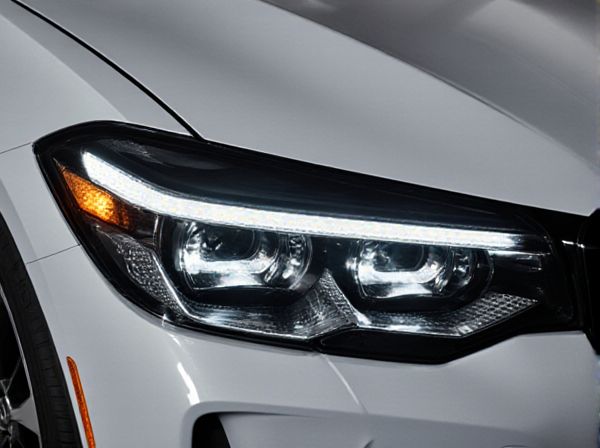
Photo illustration: LED Matrix Headlight vs Standard LED Headlight
LED Matrix Headlights offer advanced adaptive lighting technology that adjusts beam patterns based on road conditions, enhancing visibility and safety. Standard LED Headlights provide consistent, bright illumination but lack dynamic beam control, making them less effective in complex driving environments. Your choice depends on whether you prioritize cutting-edge performance or straightforward, reliable lighting.
Table of Comparison
| Feature | LED Matrix Headlight | Standard LED Headlight |
|---|---|---|
| Technology | Advanced matrix of individually controlled LEDs | Single, fixed LED array |
| Light Distribution | Adaptive, dynamic beam pattern with automatic glare control | Static beam with no adaptive functionality |
| Visibility | Enhanced visibility with intelligent light adjustment | Good visibility but limited in complex conditions |
| Energy Efficiency | High efficiency with precise power use | Efficient but less optimized |
| Lifespan | Long lifespan due to advanced LED technology | Long lifespan but potentially shorter than Matrix LEDs |
| Cost | Higher initial cost due to technology complexity | Lower initial cost and simpler design |
| Safety | Improved safety with adaptive glare reduction and better illumination | Standard safety with uniform illumination |
Introduction to Automotive LED Lighting Technologies
LED matrix headlights utilize an array of individually controllable LEDs to provide adaptive lighting that enhances visibility and safety by dynamically adjusting beam patterns to avoid glare and highlight road features. Standard LED headlights offer consistent, high-intensity illumination with improved energy efficiency and longer lifespan compared to traditional halogen bulbs but lack the advanced beam-shaping capabilities of matrix systems. Automotive LED lighting technologies continue to evolve, integrating smart sensors and control units to optimize driver vision and reduce energy consumption in modern vehicles.
What Are Standard LED Headlights?
Standard LED headlights utilize light-emitting diodes arranged in a fixed pattern to provide consistent illumination, offering improved brightness and energy efficiency compared to traditional halogen bulbs. These headlights deliver a uniform beam with limited adaptability, making them reliable but less versatile in varying driving conditions. Standard LED headlights also tend to have a longer lifespan and lower power consumption, contributing to overall vehicle efficiency.
Understanding LED Matrix Headlights
LED Matrix headlights utilize advanced segmented LED technology to dynamically adjust light patterns, enhancing visibility without blinding oncoming traffic. Standard LED headlights provide a uniform light beam with fixed intensity and coverage, lacking adaptive features. Understanding the matrix system's ability to selectively dim or activate individual LEDs is crucial for appreciating its superior safety and driving performance.
Key Differences Between LED Matrix and Standard LED Headlights
LED Matrix headlights utilize individually controlled LEDs to create adaptive lighting patterns, enhancing visibility by selectively illuminating road sections without blinding oncoming traffic. Standard LED headlights provide a uniform beam with consistent intensity, lacking the dynamic light distribution found in matrix systems. The matrix technology improves safety and driving comfort by adjusting light intensity and direction based on traffic and road conditions, whereas standard LEDs offer fixed illumination.
Brightness and Light Distribution Comparison
LED Matrix headlights offer superior brightness levels, typically ranging from 2,000 to 3,000 lumens per unit, compared to standard LED headlights, which average around 1,500 to 2,000 lumens. The matrix technology enables precise light distribution by selectively activating individual LEDs to avoid glare and optimize road illumination, enhancing visibility in complex driving conditions. Standard LED headlights provide a uniform beam pattern but lack the adaptive capabilities of matrix systems, resulting in less efficient light dispersion and potential hotspots.
Adaptive Lighting Capabilities
LED Matrix Headlights offer advanced adaptive lighting capabilities by dynamically adjusting individual LEDs to optimize beam patterns and reduce glare for oncoming traffic, unlike Standard LED Headlights that provide fixed, uniform illumination. This technology enhances night driving safety by selectively illuminating the road and surrounding environment based on real-time sensor data and traffic conditions. The precise control of light distribution in LED Matrix systems improves visibility without compromising other drivers' comfort, setting them apart from traditional LED headlight setups.
Energy Efficiency and Longevity
LED matrix headlights offer superior energy efficiency by using individually controlled LEDs that optimize power consumption compared to standard LED headlights, which operate at a constant intensity. The advanced technology in LED matrix headlights extends longevity through better heat management and reduced wear on individual diodes. Standard LED headlights, while efficient, typically have a shorter lifespan due to uniform usage and higher thermal stress.
Safety Benefits and Road Visibility
LED Matrix headlights enhance safety by dynamically adjusting light patterns to eliminate glare for oncoming traffic while maximizing road illumination, significantly improving visibility in diverse driving conditions. Standard LED headlights offer consistent brightness but lack adaptive features, which may reduce effectiveness in complex lighting scenarios such as urban environments or winding roads. Advanced sensor integration in matrix headlights supports real-time adjustments that increase driver awareness and reduce accident risks during nighttime or adverse weather driving.
Cost and Maintenance Considerations
LED Matrix headlights generally have a higher upfront cost due to advanced technology and integration of multiple LEDs with adaptive features, compared to standard LED headlights that use a simpler, fixed design. Maintenance expenses for LED Matrix headlights tend to be greater because of their complex electronics and potential for component failures, whereas standard LED headlights typically require less frequent repair or replacement. Long-term cost efficiency may favor standard LED headlights, especially in budget-conscious scenarios where advanced functionality is not a critical requirement.
Which Headlight Technology Suits Your Needs?
LED matrix headlights offer adaptive beam patterns that enhance nighttime visibility by dynamically adjusting light distribution to avoid glaring other drivers, making them ideal for urban and highway driving. Standard LED headlights provide consistent, bright illumination with lower cost and simpler design, suitable for everyday driving conditions without the complexity of advanced sensor systems. Choosing between matrix and standard LED headlights depends on your driving environment and preference for safety features versus affordability.
 caratoz.com
caratoz.com